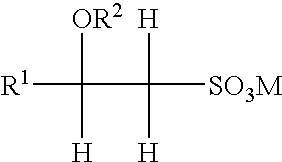Rheology modifying systems and detersive compositions comprising same
a technology of rheology modifiers and compositions, applied in the direction of detergent compositions, detergent compounding agents, hair cosmetics, etc., can solve the problems of unmet desired lather levels and later profiles, poor operation at another stage, and negative interaction of rheology modifiers
- Summary
- Abstract
- Description
- Claims
- Application Information
AI Technical Summary
Benefits of technology
Problems solved by technology
Method used
Image
Examples
examples 1-4
can be prepared by conventional formulation and mixing techniques, such as described hereafter. Add the water into an appropriately sized and cleaned vessel. Begin stirring (stir speed ˜100-300 rpm) and heating to 60-65° C. Weigh the Laponite XLS into a plastic weigh-boat (by weight percent). Once the water temperature has reached 40° C., slowly add the Laponite to the water while continuing to heat and stir. Once the temperature has reached 60° C. to 65° C., hold the mixture at that temperature for approximately 5 minutes or until all of the Laponite is in solution. Weigh the CMEA into a plastic weigh boat and add to the Laponite / Water mixture while continuing to stir. Add the Disodium EDTA; Ammonium Laureth-3-Sulfate (SLE3S); and Ammonium Lauryl Sulfate (ALS); by weight percent. If needed, add the Sodium Chloride. If needed, add the Stabileze 06 / Water dispersion and the UCARE Polymer LR-400 / Water dispersion (See notes below) and continue to heat to 60° C. to 65° C. while mixing. O...
examples 5-7
can be prepared by conventional formulation and mixing techniques, such as follows: prepare a citric acid premix by adding citric acid in water at 1:3 ratio. Also, prepare a dispersion of the stabilize 06 in water. Then, add the water to the main mix vessel and heat to 40° C. Add the Laponite while continuing to heat to 60° C. Mix until clear. Add the following ingredients into the main mixing vessel with agitation: CMEA, ammonium lauryl sulfate, ammonium laureth-3 sulfate, Sodium laureth-3 sulfate; sodium lauryl sulfate; cocamidoproply betaine; citric acid premix, Miranol L-32 ultra, sodium chloride, sodium benzoate, disodium EDTA, lauric acid, Polyox WSR 301. Heat the vessel with agitation until it reaches 88° C., then add petrolatum. Mix for about 10 min. Cool the batch with a cold water bath with slow agitation until it reaches 43° C. Add the following ingredients: Glydant, perfume, and Expancel. Keep mixing until homogeneous.
Examples 8-10
Personal Cleansing Compositions
[0058]
891...
examples 8-10
can be prepared by conventional formulation and mixing techniques, such as follows: first prepare a citric acid premix by adding citric acid into water at 1:3 ratio. Then, add the following ingredients into the main mixing vessel in the following sequence with agitation: water and heat to 40° C., Laponite while continuing to heat to 60° C. Mix until clear. Add the following ingredients into the main mixing vessel with agitation: CMEA, Expancel, Polyox WSR 301, and Miracare SLB-365; Ammonium Laureth-3-3-sulfate; ammonium lauryl sulfate; sodium laureth-3-sulfate; sodium lauryl sulfate; cocamidopropyl betaine and primaflo MP3295A. Adjust the pH to 6.0 using citric acid premix. Then, add sodium chloride, disodium EDTA, sodium benzoate, glydant, and perfume. In a separate vessel, prepare a lipid premix by adding Petrolatum into Mineral oil and heat to 88° C. Cool the lipid premix to 38° C. and add into the main batch. Adjust pH to 6.0. Keep mixing until homogeneous.
Examples 11-13
Personal...
PUM
| Property | Measurement | Unit |
|---|---|---|
| viscosity | aaaaa | aaaaa |
| viscosity | aaaaa | aaaaa |
| viscosity | aaaaa | aaaaa |
Abstract
Description
Claims
Application Information
 Login to View More
Login to View More - R&D
- Intellectual Property
- Life Sciences
- Materials
- Tech Scout
- Unparalleled Data Quality
- Higher Quality Content
- 60% Fewer Hallucinations
Browse by: Latest US Patents, China's latest patents, Technical Efficacy Thesaurus, Application Domain, Technology Topic, Popular Technical Reports.
© 2025 PatSnap. All rights reserved.Legal|Privacy policy|Modern Slavery Act Transparency Statement|Sitemap|About US| Contact US: help@patsnap.com

